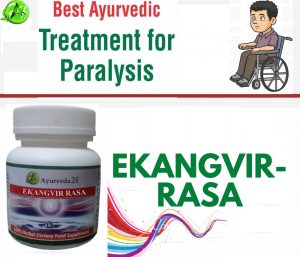Ayurvedic Treatment For Paralysis
Paralysis is loss or impairment of voluntary muscular movement caused by structural abnormalities or metabolic disturbances in nervous tissue. Paralysis will affect the legs and lower area of the body or both arms and legs. Generally, the muscles of the lower face, arm, and leg on just one aspect of the body are concerned (hemiplegia). Paralysis is either localized (affects just one part of the body) or generalized (affects a wider area of the body).
There are many sorts and degrees of paralysis.
- Partial – you still have some control of your muscles (sometimes called paresis).
- Complete – one can’t move muscles in the least.
- Permanent – muscle control never comes back.
- Temporary – some or all muscle control returns.
- Flaccid – muscles get flabby and shrink.
- Spastic – muscles are tight, hard, and jerk around oddly (spasm).
In spite of the varied treatment modalities available, Ayurveda has proved to be one of the foremost effective treatment methodologies for Paralysis or stroke conditions. So, it’s highly recommendable to require Ayurveda treatment immediately.
Ayurvedic Insights into Paralysis
In Ayurveda, paralysis is most prominently featured under the categorization of Vata vyadhi disorders because it is primarily linked to aggravated Vata dosha. It is believed when Vata has aggravated primarily within the region of the brain thanks to factors like stress, sleep deprivation, or obstruction of srotas within the brain, paralysis can develop due to adverse effects of aggravated Vata on the nerves. In revered Ayurvedic texts like the Charaka Samhita and Sushruta Samhita, Pakshaghata is the most discussed sort of paralysis. This correlates best with hemiplegia – paralysis caused by brain or medulla spinalis injury to affect one side of the body. Other terms like Paksha Vadha and Ekanga Vata also describe paralysis, which may be one among the opposite types. Facial paralysis is assessed as a completely separate disease in Ayurveda, mentioned as Ardita Vata – also linked to Vata aggravation, but together with Kapha. Ardita Vata correlates most closely with a condition known to modern medicine as Bell’s palsy.
Ayurvedic Treatment of Paralysis
The basic and most important step of Ayurvedic Treatment For Paralysis is Aamana chikitsa or palliative therapy, which may include the utilization of herbal medications, yoga, counseling, and other lifestyle changes to alleviate symptoms of paralysis, aid recovery, and promote complete rehabilitation. The herbs are utilized in Ayurvedic treatment for paralysis for its wide-ranging benefits, particularly for strengthening the systema nervosum , promoting nerve growth and regeneration, and protecting against neurodegenerative diseases.
The treatment protocol focuses on balancing the Tridoshas i.e. Vata- pitta-Kapha, correcting Agni (digestive system and cellular metabolism – Dhatwagni), and strengthening Ojus.
Ayurveda24 recommends Panchakarma therapies alongside oral medications for treating Paralysis. Oral medicines may continue for 3 – 6 months based on the recovery. Apart from these, Diet & Lifestyle modifications are essential throughout the treatment of Paralysis. Certain yoga asanas and Pranayama are particularly beneficial at restoring muscle function and also strengthening the central systema nervosum. Pranayamas like nadi shodhana and anuloma viloma are intensely relaxing and help to lower stress levels, improving pulse and vital signs.

